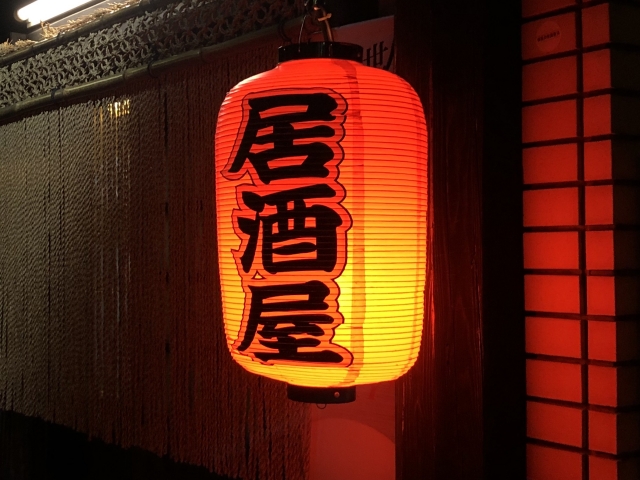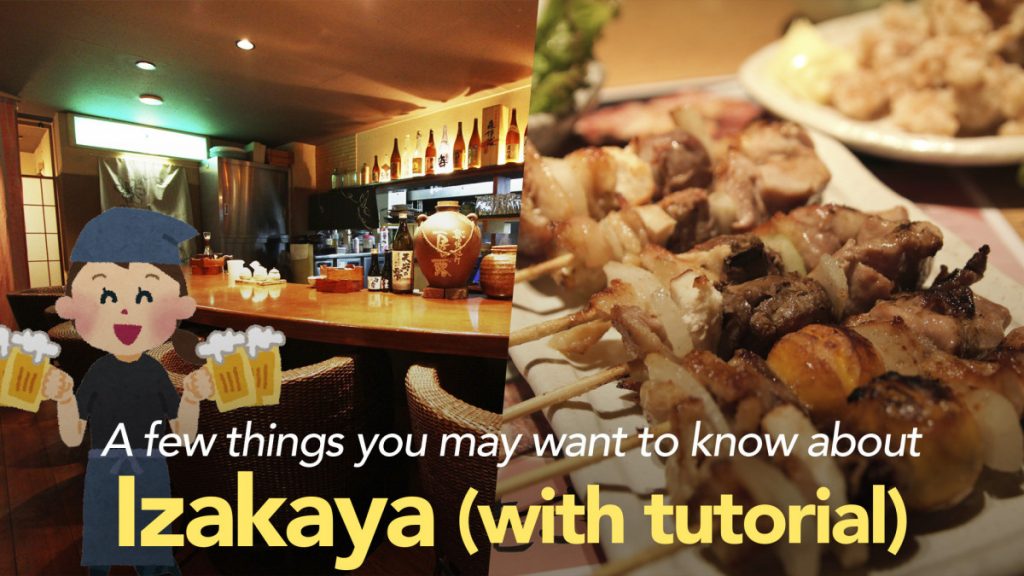Izakaya is a kind of casual Japanese bar for after-work drinking and gatherings. You can experience the daily life of local Japanese there. Non-Japanese-speaking foreigners may find exploring this kind of local culture difficult as they cannot read the menu. Here are some information that may help.

1. Greetings from staff
When you come into an izakaya, the staff usually greets you and ask the number of people. You can just smile and show the number with hand gestures.
| Japanese | Pronunciation | Meaning |
| いらっしゃいませ。 | Irasshaimase | Welcome. |
| 何名様ですか? | Nannmei sama desuka? | How many people? |
There are mainly four types of seats in the izakaya. Counter seats enable you to chat with the chef but it is hard to chat with your friends if you come to a big group. Table seats and tatami seats are suitable for a small group of people, while a private dining room allows you to chat privately in an independent room. You can choose according to your needs. There is a kind of izakaya that has no seat. People stand and drink near the counter table and it is called “tachinomi” (立ち飲み).
Seats
| Japanese | Pronunciation | Meaning |
| カウンター席 | kaunnta-seki | counter seat (facing the chef) |
| テーブル席 | teburu-seki | table seat |
| 座敷 | zashiki | tatami seat |
| 個室 | koshitsu | private dining room |
| 立ち飲み | tachinomi | standing (no seat) |
2. How to order food and drinks
After settling down, the staff will serve you with a hot wet towel or wet tissue for you to clean your hands. Here are some common utensils that you may need. There is not any smoking ban in indoor areas in Japan, it is common for Japanese to smoke when having a drink in an izakaya.
Utensils
| Japanese | Pronunciation | Meaning |
| おしぼり | oshibori | wet tissue/ wet towel |
| 割り箸 | warihashi | disposable chopsticks |
| 取り皿 | torizara | small bowl (for sharing food) |
| メニュー | menyu | menu |
| 灰皿 | haizara | ashtray |

English menu may be available in some izakayas located in popular tourist spots. But don’t worry if there is no English menu, it is not that complicated to order food and drinks in izakayas. Here are some common food and drinks in an izakaya.
Useful Sentences
| Japanese | Pronunciation | Meaning |
| 英語のメニューはありますか? | Eigo no menyu wa arimasu ka? | Do you have an English menu? |
| 注文をお願いします。 | Chumon o onegaishimasu. | I would like to order. |
| おすすめは何ですか? | Osusume wa nandesuka? | Any recommendations? |
| これをください | Kore o kudasai. | This one please. |
It is quite interesting that usually you will be served with a compulsory appetizer before making an order. The Japanese call it “otoshi” (お通し). It costs around 300-500 yen and you cannot refuse to have it. This is an unspoken rule in izakayas so need not to be too surprised.
Food
| Japanese | Pronunciation | Meaning |
| お通し | otoshi | compulsory appetizer that served before placing order |
| おつまみ | otsumami | snacks (to have with a drink) |
| 漬物 | tsukemono | pickles |
| 枝豆 | edamame | green soybeans |
| 玉子燒 | tamagoyaki | tamagoyaki (rolled omelette) |
| 焼き鳥 | yakitori | grilled chicken |
| 鶏の唐揚げ | tori no kara-age | fried chicken |
| 軟骨の唐揚げ | nankotsu no kara-age | fried cartilage |
| 冷奴 | hiyayakko | cold tofu |
| ハムカツ | hamu-katsu | fried ham |
| フライドポテト | furaido-poteto | French fries |
| 豚の角煮 | buta no kakuni | braised pork |
| 牛すじの煮込み | gyūsuji no nikomi | stewed beef tendon |
| 刺身盛り合わせ | sashimi moriawase | sashimi platter |
| お茶漬け | ochazuke | chazuke (rice with tea) |
| 雑炊 | zosui | hodgepodge/ porridge |




There are different kinds of alcoholic and non-alcoholic drinks served in iazakayas.
Drinks
| Japanese | Pronunciation | Meaning |
| ビール | biru | beer |
| 生ビール | namabiru | draught beer |
| ウィスキー | wisuki | whiskey |
| 日本酒 | nihonshu | sake |
| 焼酎 | shochu | shochu/ liquor |
| 梅酒 | umeshu | plum wine |
| 果実酒 | kajitsushu | fruit wine |
| ノンアルコール飲料 | non-arukoru | non-alcoholic drinks |
| ウーロン茶 | ūroncha | oolong tea |
| ジンジャーエール | jinja-eru | ginger ale |
| オレンジジュース | orenji-jusu | orange juice |
| カルピス | karupisu | Calpis |
You will be asked how to serve your drink when you order liquor or fruit wine. For example, staff will serve you plum wine on the rocks (with ice) when you order “梅酒、ソーダ割りで”. Just feel free to choose the style you like.
| Japanese | Pronunciation | Meaning |
| ストレート | sutoreto | straight/ neat |
| ロック | roku | on the rocks |
| 水割り | mitsu-wari | with water |
| お湯割り | 0yu-wari | with hot water |
| ソーダ割り | soda-wari | with soda |
3. Okawari (おかわり) and “shime” (シメ)
When you want to order the same thing again, there is a convenient saying “okawari kudasai” (おかわり下さい). It means “please give another (one)”. If you go to an izakaya with Japanese they may suggest ordering “shime” (シメ) near the end of drinking. “Shime” in fact is not the name of a dish but it refers to the “the action of making the last order and finish today’s drinking”. Japanese usually order food like rice balls, ramen, udon or ochazuke, etc. as the ending dish.
4. Leaving izakaya
Staff will come up to you with the bill when you ask for it. You can say ” gochisosama deshita” (ごちそうさまでした) to thank the staff and the chef for the meal.
Useful Sentences
| Japanese | Pronunciation | Meaning |
| お会計をお願いします。 | okaike o onegaishimasu. | May I have the bill please. |
| ごちそうさまでした。 | gochisosama deshita. | Thank you for the meal. |

